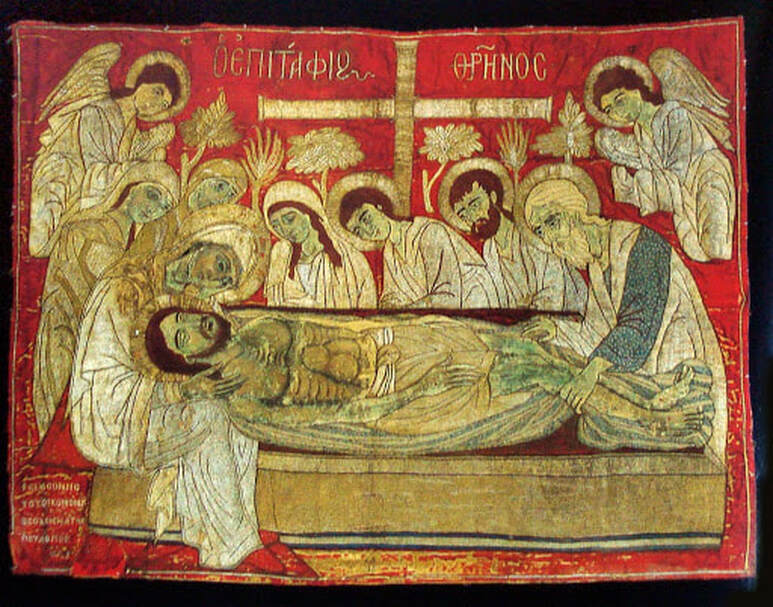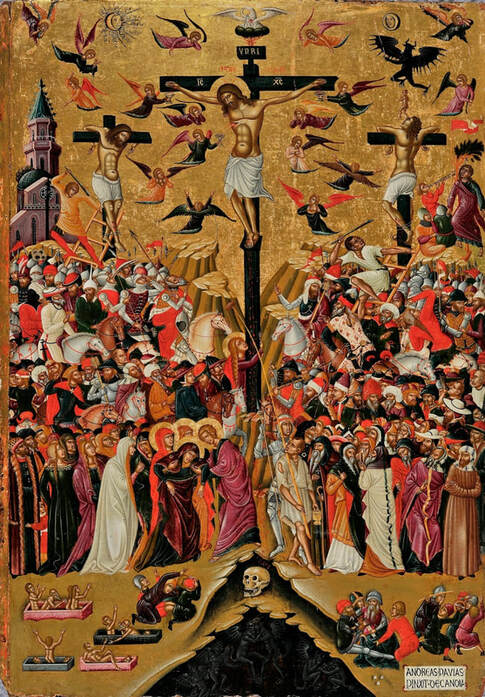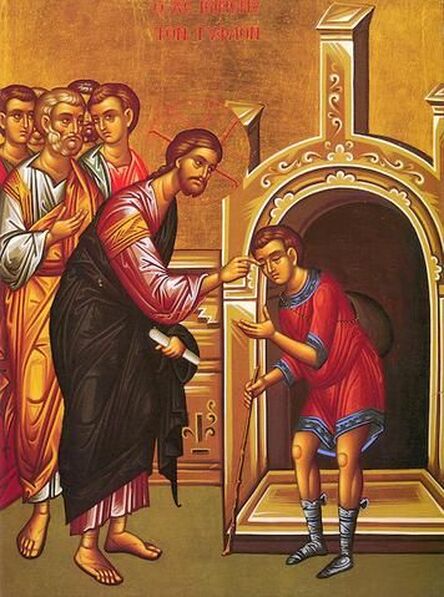Good Friday afternoon - Apokathelosis
This is the Vespers of Good Friday. It is also called the Apokathelosis – or “unnailing from the cross.” We remember that at this time, Christ “gave up His Spirit.” During the service, the icon of Christ is taken down from the cross and wrapped in a white cloth, which symbolizes His burial garment. The icon of the body is taken into the altar and remains there until after the Feast of the Ascension. This is symbolic because the altar, in particular the Altar Table/Holy Table, is symbolically the tomb of Christ. What comes from the tomb of Christ? Life and the Risen Lord. What comes from the Altar? Life and the Risen Lord in the Holy Communion that is prepared and of which we can partake. As Christ came forth from the tomb giving Life, so does the priest come forth from the altar and offer life when he says, “with the fear of God, faith and love draw near” as he brings forward the Holy Communion for the people. Also, the priest processes with the Epitaphion. The Epitaphion is the icon that is placed in the beautifully decorated wooden tomb. The Epitaphion is not the wooden tomb that is decorated with all of the flowers – that is called the kouvouklion. The priest places the Epitaphion in the kouvouklion at the end of the procession. Theme: salvation granted to us through His “awful Passion, the Cross, and condescension to voluntary entombment in the flesh.
Themes: The Mystical (Last) Supper; Jesus washing the feet of the Disciples, the Garden of Gethsemane
Gospel Reading: Matthew 26:2-20, John 13:3-17, Matthew 26:21-39, Luke 22:43-45, Matthew 26:40 – 27:2 Remember, even though this service takes place in the morning, it is really part of a Great Vespers service for Thursday evening. The Mystical Supper took place in the evening on a Thursday. Today, we remember Mystical Supper on Thursday, but in the morning instead of in the evening.
*(Sung on Tuesday night)
Themes: The faithful woman who anointed the head of Jesus with costly, fragrant oil; the selfishness and greed of Judas; Jesus as a suffering servant. Gospel Reading: John 12:17-50 Beloved Brothers and Sisters in Christ, On this day, we remember the woman who used very expensive oil to anoint the head of Jesus (Mt. 26:6-13). Christ says that she did this “For in pouring this fragrant oil on My body, she did it for My burial.” This was done shortly before Jesus’ passion, or just before He was to suffer for all of mankind. Christ even says, “Assuredly, I say to you, wherever this gospel is preached in the whole world, what this woman has done will also be told as a memorial to her.” Of course, these words are true today. Throughout the world, her gift to Christ has been made known. In fact, on Tuesday night, we hear the Hymn of Kassiani, which describes this selfless act of love towards our Lord and Savior Jesus Christ. Even the disciples thought the money she used on the oil would be better used if given to the poor. But Jesus says she did a great thing because we will always have a chance to help the poor around us, but we may not always get the chance of helping Christ Himself. Holy Tuesday* (Taking place on Monday night)
Themes: Parable of the 10 Virgins, Alertness/Attentiveness, the hypocrisy of the scribes and Pharisees, Second Coming of Christ Gospel Reading: Matthew 22:15-46, 23:1-39 Beloved Brothers and Sisters in Christ, The Fathers of the Church who put together the services over time, especially the services of Hoy Week, have really done an extraordinary job. In fact, only through the Holy Spirit could such a task have been accomplished. Each service connects with the previous one and continues the demonstrative, pedagogic, edifying, beautiful, agonizing, and glorious recounting of the Passion and Resurrection of Christ. If we are paying attention to the hymns and readings, we will be taken through Jesus’ final discourses to His disciples and the people. It will be as if we were present at the Last Supper and Garden of Gethsemane. We become witness to the betrayal, arrest, and mock trial of Jesus. We agonize with Jesus’ passion and sing gloriously upon His resurrection.
Have you ever heard of a triumph? I do not simply mean a victory, but a Roman-style triumph. When the Romans were victorious over another nation or peoples, the army would return to Rome. In the days of the Roman Republic, a triumph was granted to a great general by the senate (in Imperial Rome, the Emperor reserved the triumph only for himself as the “savior of Rome”). During such a procession/parade, the people would gather at the Campus Martius, enter the city through the Triumphal Gate, and slowly make its way to the Capitoline Hill and to the temple of Jupiter with prayers offered to the gods. The procession could take hours or even days! The procession was led by the leaders and peoples captured by the Romans, usually in chains. Some would be in cages and mocked, others would be publicly executed. After the captured people would come the loot gained from the conquest and any exotic treasures, art or beasts captured. At this point, artistic renderings of the battles and conquests would often be processed. Then came the senators and magistrates followed by the general drawn by a four-horses chariot and wearing a laurel (bay leaves) crown (representing victory). Finally, the soldiers, dressed as civilians, unarmed, and wearing laurel crowns as well, would bring up the rear of the triumph singing ribald songs (songs of crude and vulgar nature) to the general. The procession was met by the citizens of Rome with singing and flowers being strewn in the path. A triumph was an incredible public spectacle for all the people in Rome.
|
AuthorsMessages written by the clergy of our parish. Archives
May 2021
Categories
All
|
© 2023
Saint Nicholas Greek Orthodox Church
3109 Scio Church Road, Ann Arbor, MI 48103
Phone: (734) 332-8200
Fax: (734) 332-8201
Saint Nicholas Greek Orthodox Church
3109 Scio Church Road, Ann Arbor, MI 48103
Phone: (734) 332-8200
Fax: (734) 332-8201











 RSS Feed
RSS Feed
